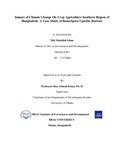Impact of climate change on crop agriculture southern region of Bangladesh: a Case Study of Banaripara Upazila ,Barisal.

View/
Date
2018-03Publisher
BRAC UniversityAuthor
Islam, Md. ShahidulMetadata
Show full item recordAbstract
The study was conducted on disaster prone area of Banaripara upazila Barisal, Bangladesh. The
objective of the study was to find out the existing agricultural production system and how
climate change is affecting agricultural cropping pattern. Primary data were collected using
multiple approaches, e.g. key informant interviews, 40 interviews of each village of two.
According to the resource map, there have very small amount of forest cover and forest reserve
areas in the study areas. The stratification of the surveyed villages indicated that there were three
wealth groups in both villages. On the context of the status of the three wealthy groups, it implies
that vulnerabilities and adaptive capacities among groups vary accordingly in the two villages
studied. From the field survey, it was clear that that the local responses on climate changes were
more significant on their perceptions. It has been reported that the area becomes extremely hot
during the day but during the night it remains very cold. This study also showed variation on
rainfall patterns in different seasons. The average minimum temperature is decreasing but the
average maximum temperature is increasing. The Rabi crops are less vulnerable to change
rainfall rate in winter as the production rate of potato, vegetables and banana are increasing
trends or constant. In Kharif season, paddy, mustard and wheat production varied with the rise
and fall of rainfall intensity. In Kharif-II season, transplanted aman production showed the
constant trends of production but the vegetables production fluctuated with the fluctuation of
rainfall and temperature.
